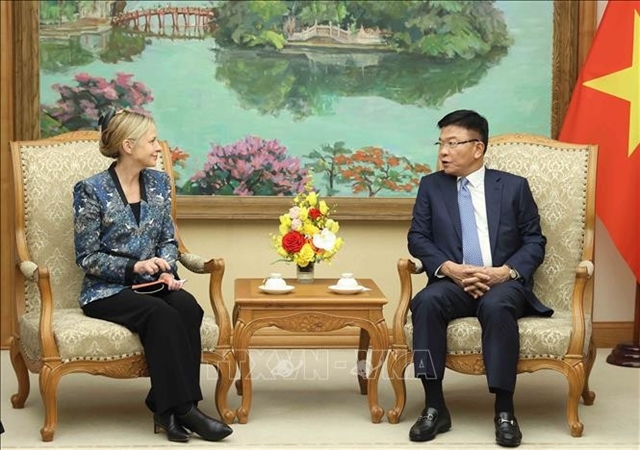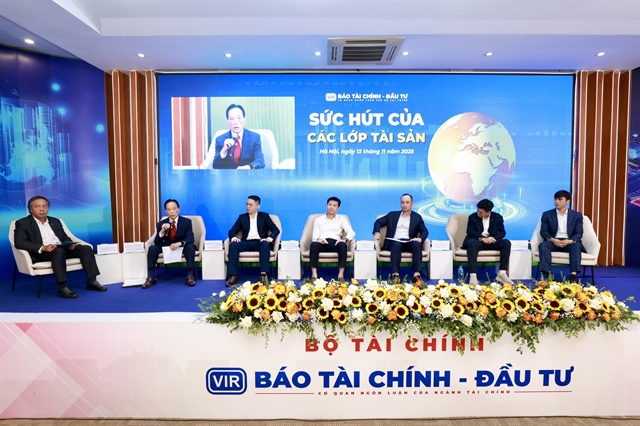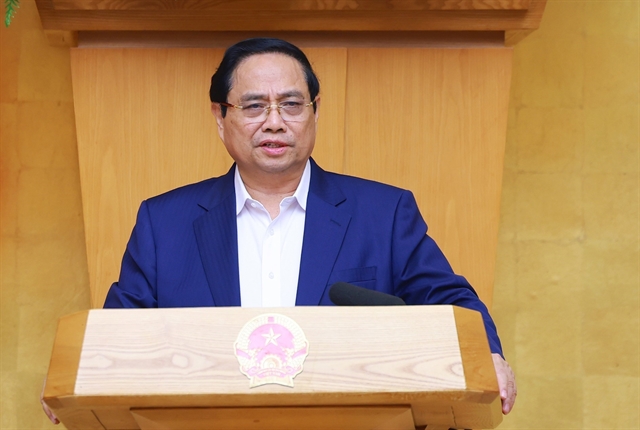 Economy
Economy


|
| Experts during a panel discussion at the workshop. Photo courtesy of the organiser |
HÀ NỘI — Việt Nam’s investment landscape is entering a period of rapid transformation, driven by new legal frameworks, strong macroeconomic fundamentals, and an ambitious national push to elevate its sovereign credit rating, attendees heard at a workshop titled 'The Allure of Asset Classes' that was held in Hà Nội on Thursday.
Experts said these combined forces are reshaping capital flows across both traditional and emerging asset classes, positioning the country for deeper integration into global financial markets.
They said that four strategic resolutions recently issued by the Politburo have strengthened policy clarity and improved market confidence. International institutions have increasingly recognised Việt Nam as one of Asia’s rising stars, while forecasts for trade and investment in 2026 and beyond remain broadly optimistic.
The country’s stock market is expected to benefit significantly from ongoing efforts to upgrade its status from a 'frontier' market to an 'emerging' market, said Nguyễn Trí Hiếu, Director of the Institute for Global Financial and Real Estate Market Research and Development.
Set to take place in 2026 pending a final review, the upgrade could unlock tens of billions of US dollars from global investment funds. The real estate market is also projected to improve as land-related legal reforms take effect next year.
Digital finance
Việt Nam’s financial ecosystem is set for further momentum as the country prepares to operationalise its International Financial Centre (IFC). According to founder and CEO of Nami Foundation Giáp Văn Đại, the IFC marks a strategic step in Việt Nam’s integration with global financial flows. It is expected to pave the way for modern investment products like digital assets, tokenised real-world assets, and fintech-driven investment platforms.
Đại said blockchain and fintech firms could provide the operational infrastructure for next-generation financial tools, ranging from smart contracts to decentralised finance applications.
Early controlled pilots launched by banks, logistics providers, and insurers are helping build compliant models suited to Việt Nam’s regulatory environment. These advancements, he noted, could enhance transparency, competitiveness, and Việt Nam’s attractiveness to global investors in technology and innovation.
Specialists also see strong long-term potential for digital assets. Nghiêm Minh Hoàng, a fintech expert with the Vietnam Blockchain and Digital Asset Association, said non-real-world-backed assets like bitcoin show a positive outlook over the next three to five years, as more governments and major funds treat them as reserve assets.
Meanwhile, tokenised real-world assets could make up nearly 10 per cent of global GDP in the next five to seven years, helping unlock liquidity for traditional assets that typically draw limited capital.
Adding to the momentum is Việt Nam’s ambition to achieve an 'Investment Grade' sovereign rating, a goal viewed as key to unlocking long-term capital and lowering borrowing costs. At the seminar, Vũ Việt Linh, Deputy Director of Institutional Client Analysis at Maybank Investment Bank, said Việt Nam will require US$250–280 billion annually from 2025 to 2030 to fund infrastructure, energy, digital transformation, and manufacturing expansion.
Reaching 'Investment Grade' would mark a decisive shift, moving Việt Nam out of the “high-risk” category and into a rating accepted by most global institutional investors.
The upgrade could reduce borrowing costs for the Government, banks, and businesses by 150–300 basis points, immediately improving investment efficiency and competitiveness in the private sector. It would also open the door to long-term capital from pension funds, insurance funds and sovereign wealth funds – sources known for their stability and large-scale commitments.
However, Fitch, S&P, and Moody’s all point to three key challenges: the need to improve legal transparency to match 'emerging market' standards; risks in the banking sector, where assets exceed 120 per cent of GDP but capital adequacy ratios remain below regional peers; and declining foreign reserves due to exchange rate pressures in recent years.
According to Linh, these challenges are not structural roadblocks. Strengthening institutional reforms, addressing cross-ownership in banks, improving financial governance, and enhancing the quality of macroeconomic data – especially the balance of payments – will be critical foundations for a rating upgrade in the next review cycle.
Reforms
Việt Nam has accelerated multiple reform programmes since 2024 to align with international standards. The Government has streamlined administrative procedures, cut 30 per cent of business regulations and advanced legal modernisation under Resolution 66.
Policies to boost private sector development under Resolution 68 and plans to expand capital markets are also underway. By 2030, Việt Nam hopes to reach stock market capitalisation of 120 per cent of GDP and corporate bond debt equal to 25 per cent of GDP, a major leap from current levels.
Banks are also strengthening their capital buffers. Major commercial banks have been retaining profits to expand capital, while State-owned lenders like BIDV and Vietcombank have prepared plans to increase capital in line with Basel II and Basel III requirements. These steps, analysts say, are essential for credit rating agencies to assess systemic banking resilience.
Externally, Việt Nam continues to maintain a current account surplus and stable FDI inflows and plans to issue USD-denominated bonds to boost foreign reserves. Although reserves remain adequate under IMF guidance, a larger buffer will be needed as the economy expands and absorbs higher volumes of cross-border financial transactions.
Optimistic outlook
Based on the current reform trajectory, Linh estimated that Việt Nam could achieve Investment Grade as soon as 2028 under an optimistic scenario and by 2030 under a baseline scenario. Such an upgrade would usher in a new phase of lower capital costs, wider economic opportunities, and more sustainable foreign investment inflows.
Despite the optimistic outlook, experts emphasised the importance of caution, especially as asset classes continue to fluctuate amidst domestic and global policy changes. Sharp movements in stocks, gold, real estate, and digital assets highlight the need for investors to remain vigilant, selective, and well informed.
Stock gains, for instance, have not translated into universal profits; many investors have incurred losses due to unsuitable portfolio choices. In digital assets, tokenised real-world assets remain limited for domestic investors and are currently prioritised for foreign investors, while risks still stem primarily from human errors and operational management rather than technology.
As Việt Nam strengthens its legal and financial foundations, accelerates institutional reforms, and embraces new investment technologies, economists say the country is approaching a pivotal moment.
If the current reform momentum continues, Việt Nam could not only achieve an 'Investment Grade' rating within the next decade but also reshape its entire investment landscape, attracting new capital flows, boosting investor confidence, and sustaining long-term growth.
With both traditional and emerging asset channels moving in tandem, Việt Nam is positioning itself to capture the next wave of global investment opportunities in an increasingly competitive region. — VNS




